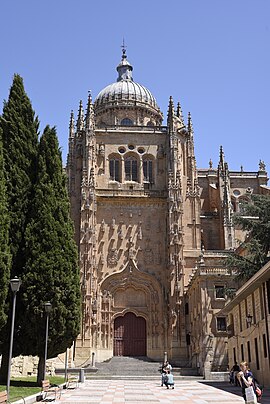

Plateresque, meaning "in the manner of a silversmith" (plata being silver in Spanish), was an artistic movement, especially architectural, developed in Spain and its territories, which appeared between the late Gothic and early Renaissance in the late 15th century and spread over the next two centuries. It is a modification of Gothic spatial concepts and an eclectic blend of Mudéjar, Flamboyant, Gothic, and Lombard decorative components, as well as Renaissance elements of Tuscan origin.[1]
Examples of this syncretism are the inclusion of shields and pinnacles on façades, columns built in the Renaissance neoclassical manner, and façades divided into three parts (in Renaissance architecture they are divided into two). It reached its peak during the reign of Charles V, Holy Roman Emperor,[2] especially in Salamanca, but also flourished in other such cities of the Iberian Peninsula as León, Burgos, Santiago de Compostela, also in the territory of New Spain, which is now Mexico, and in Bogotá.[1][2]
Plateresque has been considered down to current times a Renaissance style by many scholars. To others, it is its own style, and sometimes receives the designation of Protorenaissance.[3][4] Some even call it First Renaissance in a refusal to consider it as a style in itself, but to distinguish it from non-Spanish Renaissance works.[5]
The style is characterized by ornate decorative façades covered with floral designs, chandeliers, festoons, fantastic creatures and all sorts of configurations.[2] The spatial arrangement, however, is more clearly Gothic-inspired. This fixation on specific parts and their spacing, without structural changes of the Gothic pattern, causes it to be often classified as simply a variation of Renaissance style.[6] In New Spain the Plateresque acquired its own configuration, clinging tightly to its Mudéjar heritage and blending with Native American influences.[2]
In Spain its development is most remarkable in the city of Salamanca although examples are found in most regions of the country.
In the 19th century with the rise of historicism, the Plateresque architectural style was revived under the name of Monterrey Style.[7]
- ^ a b Bozal, Valeriano; Art history in Spain: From the origins to the Enlightenment, pp. 157, 165. Ed Akal (1978). ISBN 978-84-7090-025-9.
- ^ a b c d Arellano, Fernando; The Hispanic American Art, pp. 13–14. Ed. Universidad Católica Andrés (1988). ISBN 978-980-244-017-7.
- ^ Cite error: The named reference
ariaswas invoked but never defined (see the help page). - ^ Marías, Fernando; The 16th century: Gothic and Renaissance, p. 24. Ed. Silex Ediciones (2002). ISBN 978-84-7737-037-6.
- ^ Cite error: The named reference
alonsowas invoked but never defined (see the help page). - ^ Bendala Galán, Manuel; Manual of the Spanish art, p. 416. Ed. Silex Ediciones (2003). ISBN 978-84-7737-099-4.
- ^ Bendala 2003, p. 739